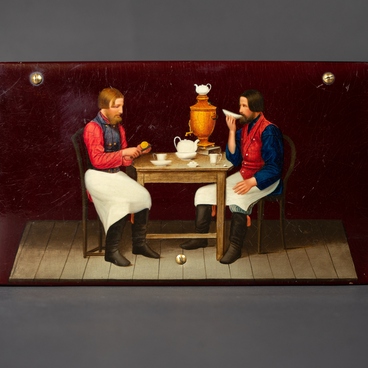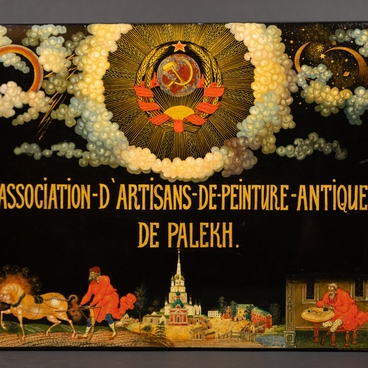Lacquer miniature painting produced by the Lukutin and Vishnyakov workshops was closely connected with the Russian Realist tradition. At the beginning of the 19th century, Vishnyakov masters mostly copied realist artworks. But gradually they developed a special style of lacquer miniature: mainly, they created images with depictions of folk life with a romantic, sublime interpretation.
One of the first references to the troika theme (troikas were carriages drawn by three horses) in lacquer art originated in the work of painter Alexander Orłowski. Miniature artists repeatedly copied his ‘Troika with a Courier’, painted in 1812. Consequently, the public fell in love with summer and winter troikas copied from paintings by Pyotr Gruzinsky, Nikolai Sverchkov and others.
The masters did not simply copy paintings with strict accuracy: compositions varied depending on the artist. Each master transformed the original, interpreted it differently, adding small, sometimes barely noticeable details. Thus, the image was constantly enriched and developed.
People started to use the troika on Russian roads at the turn of the 17th century. At first it was used for speedy delivery of mail. But passengers appreciated the speed, endurance and good cross-country ability of the troika. Thus, civil servants, couriers and passengers began to travel in troikas. Over time, a custom of riding on a troika during one’s wedding became popular among the Russian people.
The Russians invented a unique harness which allowed to use different gaits: the shaft horse — a strong and large horse — was harnessed in the center and moved at a trop, while the tracers — horses on the sides — maintained a brisk gallop. This specific alignment gave the troika a dizzying speed — 45 to 50 kilometers per hour.
The Russian troika has become an unofficial symbol of Russia. It is associated with the vast expanses, speed, spaciousness, and embodies the national character. Thus, one of the most famous images of classic Russian literature is the “Bird-Troika” to which Nikolai Gogol compared Russia:
One of the first references to the troika theme (troikas were carriages drawn by three horses) in lacquer art originated in the work of painter Alexander Orłowski. Miniature artists repeatedly copied his ‘Troika with a Courier’, painted in 1812. Consequently, the public fell in love with summer and winter troikas copied from paintings by Pyotr Gruzinsky, Nikolai Sverchkov and others.
The masters did not simply copy paintings with strict accuracy: compositions varied depending on the artist. Each master transformed the original, interpreted it differently, adding small, sometimes barely noticeable details. Thus, the image was constantly enriched and developed.
People started to use the troika on Russian roads at the turn of the 17th century. At first it was used for speedy delivery of mail. But passengers appreciated the speed, endurance and good cross-country ability of the troika. Thus, civil servants, couriers and passengers began to travel in troikas. Over time, a custom of riding on a troika during one’s wedding became popular among the Russian people.
The Russians invented a unique harness which allowed to use different gaits: the shaft horse — a strong and large horse — was harnessed in the center and moved at a trop, while the tracers — horses on the sides — maintained a brisk gallop. This specific alignment gave the troika a dizzying speed — 45 to 50 kilometers per hour.
The Russian troika has become an unofficial symbol of Russia. It is associated with the vast expanses, speed, spaciousness, and embodies the national character. Thus, one of the most famous images of classic Russian literature is the “Bird-Troika” to which Nikolai Gogol compared Russia:



